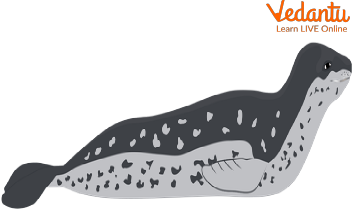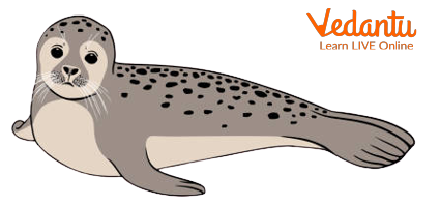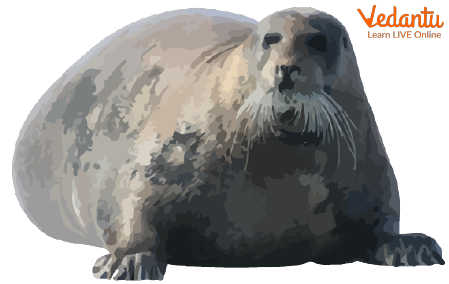




Why Are Seals Important? Key Facts and Examples for Learners
Kids, wouldn’t you agree that we must have never met an animal as charismatic as a seal? They are considered the true personalities of the sea, also known as clowns of the marine world. They are marine animals much like whales, walruses, sea lions, and sea otters. You can easily locate seals everywhere in the world. Seals are semi-aquatic mammals who are adopted for swift and graceful swimming. They are warm-blooded mammals who live on or near the sea. In this article, we will learn all about seals, the different types of seals, what they eat, some Seal facts for kids and much more.
Characteristic Features of Seals
The physical features of seals are as follows:
Seals or Pinnipeds have streamlined bodies.
They have short limbs.
They have good vision in water as they have round and large eyes.
They also have a very strong sense of smell, which helps them to look out for their predators.
They have good hearing and it helps both in water and on land.
They have webbed and long feet, forming flippers.
Seals have around twice as much blood as humans.
Habitat
Seals live in the coldest oceans of the Arctic and Antarctica. They actually make caves in the snow and live in it. Many times they dig holes in the ice so that they can breathe as some of them never leave the ice pack. Some species of seals live in one area and others live somewhere else. Species like Harp, Ringed, Hooded, Bearded, and Ribbon Seals live in the Arctic Ocean whereas species like Crabeater, Leopard, Ross and Weddell seals can be found in the Antarctic. You can locate some species in the Northern Pacific as well like Fur seals and Sea lions.
Different Types of Seals
Let us have a look at some of the species of seals to get more information about them.
The Elephant Seal

The Northern Elephant Seal
It is the largest seal found in the northern hemisphere and qualifies as the second largest in the world right after the southern elephant seal. The male elephant seal can live up to 14 years and females have a longer life which can go up to 20 years. They are quite social.
The Leopard Seal

The Leopard Seal
The leopard seals are quite famous as they feed on other seals as well. They are also known as sea leopards. They consist of the largest species of seals in the Antarctica region. They feed on a whole range of krills, birds, fish, and penguins.
The Grey Seal

The Grey Seal
The Grey Seal can be found in the North Atlantic. They are quite large and are 8.2 feet to 10.8 feet long. The female grey seal is 5.2 feet to 6.6 feet. They can go as deep as 230 feet to look for their prey and eat sand eels, lobsters, flatfish, and skates.
The Harp Seal

The Harp Seal
These species of seals are generally found in the Atlantic Ocean and some parts of the Arctic Ocean. They have black harp marks on their backs and are in the shape of a wishbone. When a baby is born, they are yellow-white but after some days the colour changes to white.
Harbour Seal

The Harbour Seal
They can be found in the temperate marine coastlines and the Northern Hemisphere of the Arctic. An adult Harbour seal can go up to 6.1 feet in length.
The Bearded Seal

The Bearded Seal
Popularly known as the bearded seal because of its prominent whiskers. One can locate them in the Arctic Ocean. They feed on the small prey found on the floor of the oceans like fish, clams, and squids.
What do Seals Eat?
As the popular opinion goes, Seals normally eat fish but they also prey on eel, squid, octopus, and lobsters. They are carnivorous animals, who are best suited to catch, kill and eat other animals. The Leopard seal can eat penguins and even smaller seals. Seals' parents help them to find food.
Fun Facts about Seals for Kids
Now that we have collected some facts on seals, let's share some interesting fun facts for kids:
Every year in search of food, seals migrate hundreds of miles.
You wouldn’t believe that seals can stay underwater for almost 2 hours in a stretch.
And they can easily dive into considerable depths underwater.
Seals Parents help baby seals to swim.
The male seal is called a bull, the female is called a cow and the baby seal is known as a pup.
Whenever they want to communicate with each other they make noises like trilling or clicking.
Did you know that seals are highly intelligent and curious?
They are quick learners and have good coordination skills. When in captivity, they learn the tricks speedily.
As we all know that they are great swimmers but they move on land by sliding or scooting.
Summary
In this article, we learned some amazing facts about seals. It is widely believed that the ancestors of seals had evolved from life on land to sea life. Therefore, they are creatures of both land and sea. Though we can see them walking on land, they are more comfortable and feel truly at home in the water.
We also learned that these animals are popularly hunted by humans for their blubber, meat, and their fur coats. They are also kept in captivity to perform tricks and for our entertainment. But now, new international protection laws are being made to save them from extinction. We hope this article was beneficial for you, in case of any other doubts, feel free to ask in the comments.
FAQs on Fascinating Seal Facts Every Student Should Know
1. What exactly is a seal?
A seal is a marine mammal that is perfectly adapted for life in the ocean. They have sleek, streamlined bodies, flippers to help them swim, and a thick layer of fat called blubber under their skin to stay warm in cold water. Although they hunt in the water, they must come to the surface to breathe air.
2. What are some fun facts about seals for kids?
Here are some interesting facts about these amazing animals:
- Seals are carnivores, and their diet mainly consists of fish, squid, and other sea creatures.
- They are expert divers and can hold their breath for a very long time, with some species staying underwater for up to 30 minutes.
- Baby seals are called pups.
- Seals use their sensitive whiskers to detect vibrations from prey moving in murky water.
- They rest and give birth on land or ice, a process called "hauling out."
3. Where do seals live?
Most seals live in the cold ocean waters of the Arctic and Antarctic. They spend their time hunting for food in the sea and resting on land or large blocks of ice. Some species, like the Hawaiian monk seal, are adapted to live in warmer tropical waters.
4. How can you tell the difference between a seal and a sea lion?
It's easy to confuse them, but there are two simple ways to tell them apart. First, look at the ears: sea lions have small, visible ear flaps, while true seals just have ear holes with no external flap. Second, watch them move on land. Sea lions can rotate their rear flippers forward to 'walk', but seals must wriggle on their bellies.
5. How does a seal's blubber help it survive?
The thick layer of fat called blubber is crucial for a seal's survival in icy water. It acts as a natural insulator, trapping body heat and preventing the seal from freezing. This blubber is so effective that it keeps the seal's internal body temperature stable even when the water is near freezing point.
6. What do baby seals eat?
A baby seal, known as a pup, feeds on its mother's milk. This milk is incredibly high in fat, which helps the pup grow very quickly and build its own essential layer of blubber. After they are weaned, young seals learn to hunt for fish and crustaceans on their own.
7. Why are seals so important for the ocean's ecosystem?
Seals are a key part of the marine food web. As predators, they help manage the populations of fish and squid, which keeps the ecosystem in balance. They are also an important food source for larger predators like orcas and polar bears, making them a vital link in the ocean's food chain.
8. What are the biggest threats to seals in the wild?
Unfortunately, seals face several threats, many from human activities. The main dangers include getting entangled in fishing nets, ocean pollution from plastic and chemical waste, and the loss of their sea-ice habitats due to climate change. These factors can make it difficult for them to find food and raise their young safely.









